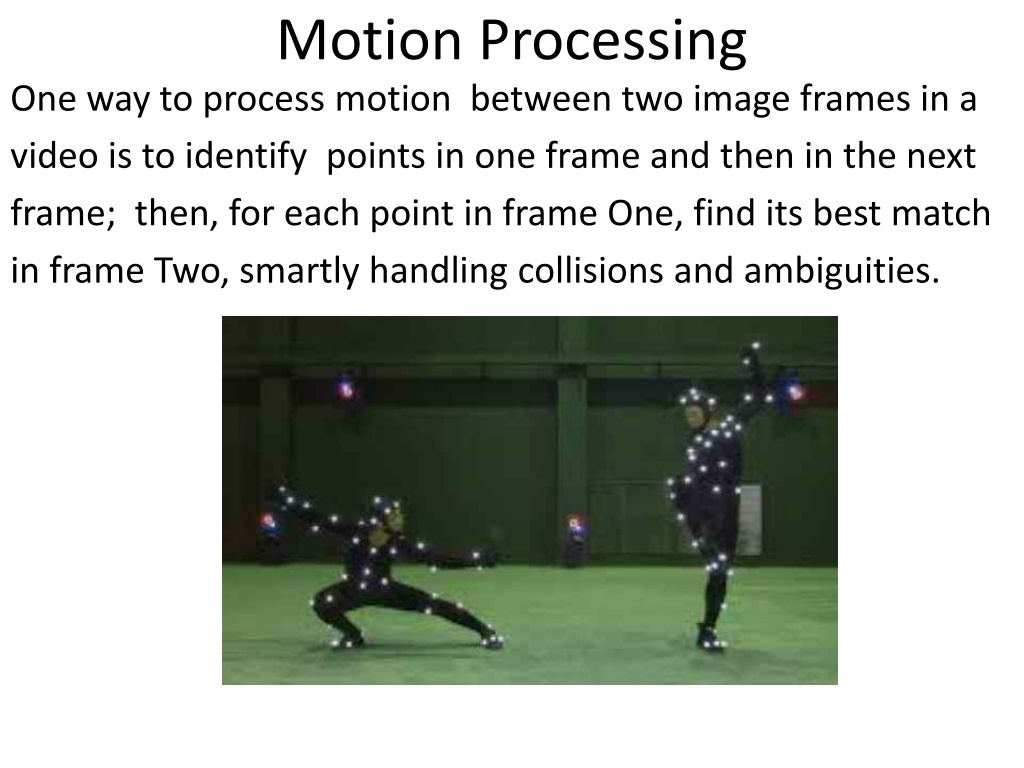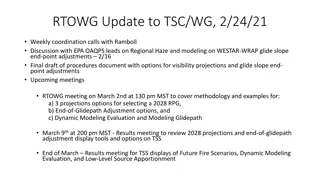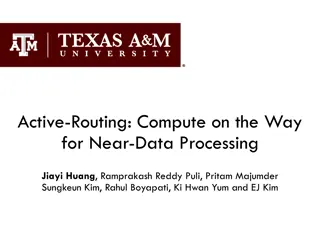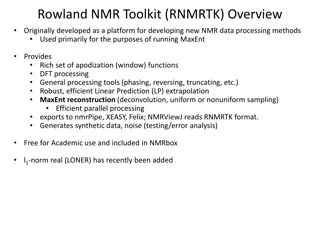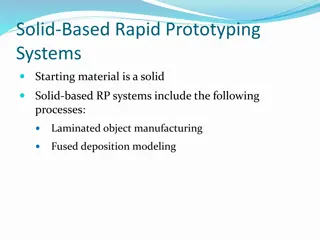Understanding Motion Processing and 2D Motion Modeling
Processing motion between image frames can be done by identifying points and finding their best matches in the next frame. Another approach based on physics and mathematics has grown in popularity. This theoretical approach now produces better results, as seen in the expected output from Optical Flow algorithm. Exploring the physics behind 2D motion modeling involves situations like viewing a floor from above and analyzing brightness patterns.
Download Presentation

Please find below an Image/Link to download the presentation.
The content on the website is provided AS IS for your information and personal use only. It may not be sold, licensed, or shared on other websites without obtaining consent from the author. Download presentation by click this link. If you encounter any issues during the download, it is possible that the publisher has removed the file from their server.
E N D
Presentation Transcript
Motion Processing One way to process motion between two image frames in a video is to identify points in one frame and then in the next frame; then, for each point in frame One, find its best match in frame Two, smartly handling collisions and ambiguities.
Motion Processing A second way is to have a definition of motion based on physics and mathematics. Until the past ten years or so, this approach was theoretically nice, but did not work in practice. Since this is an elegant theory, and now is growing in popularity, and because it works (more or less) nowadays, we present it to you. Here are two frames.
Motion Processing This figure shows the output expected from the theoretical approach (still not perfect, but much better than a decade ago).
Motion Processing Another example of real output from Optical Flow algorithm. Let us next understand how 2d motion is modeled.
Understanding the Model of 2d Motion We will examine the physics of a concrete situation. This will let us get some math equations. Imagine there is a floor being viewed by a camera from above.
Understanding the Model of 2d Motion Imagine there is a floor being viewed from above Photo credit: Shutterstock
Understanding the Model of 2d Motion Suppose there is this (ramp) pattern of Intensity (image brightness) on the floor (could be a rug).
Understanding the Model of 2d Motion The ramp s pattern of brightness (Intensity Profile) can be viewed as a plotted graph. We take one row of values and plot them.
Understanding the Model of 2d Motion Now, suppose pattern (rug) moves to the right. Dotted line shows where pattern has moved to, within unit time.
Understanding the Model of 2d Motion So, to be clear, this WAS the pattern on the floor (rug), and we are saying, imagine someone pulls the pattern (rug) to the right.
Understanding the Model of 2d Motion Now, suppose pattern (rug) moves to the right. Dotted line shows where pattern has moved to, within unit time.
Understanding the Model of 2d Motion Now, Suppose a Single Pixel Camera saw this
Understanding the Model of 2d Motion The camera (Sensor) sees the brightness change The 2 arrows show what two brightnesses the detector sees
Understanding the Model of 2d Motion The Sensor would see the brightness change The Dotted segment shows the amount of brightness drop.
Understanding the Model of 2d Motion The Sensor would see the brightness change The brightness drop is given by the distance between A and B.
Understanding the Model of 2d Motion What physical properties of this situation will determine how much brightness drop happens?
Understanding the Model of 2d Motion One factor contributing to the quantity of the brightness drop, is the speed. Speed is given by the lowermost dashed segment, because that is how much movement there was. This amount of motion is the same as the length of the segment CB.
Understanding the Model of 2d Motion One contributing factor is the speed. Make sure you understand that the faster speed will give a bigger drop, while slower speed will give smaller drop.
Understanding the Model of 2d Motion Second contributing factor is the ramp s slope. Make sure you understand that the steeper slope will give a bigger drop, while shallower slope will give a smaller drop.
Understanding the Model of 2d Motion So, drop proportional to ramp s slope & speed Let us give symbols to these quantities, so we can work them. The ramp itself is labeled I(x), for image or intensity function, varying along x. Speed is labeled u. Drop is labeled I . Slope is labeled I .
Understanding the Model of 2d Motion Speed is labeled u. Drop is labeled I . Slope is labeled I . So, we have: I u and I To convert (from proportionalities to equations), each needs a Proportionality Constant. Turns out: each is the constant of the other one. i.e., The result is: I = u I I
Understanding the Model of 2d Motion I = u I We have just argued that this equation is correct; To Prove it is much harder. Alternately, if that is the figure that goes along with this reasoning, then we can use the idea that Slope = Rise/Run, to obtain the equation: From the fig, we see that Rise is the distance between A and B, hence is I .
Understanding the Model of 2d Motion Claim: I = u I We are going to use Slope = Rise/Run, to obtain the equation: From the fig, we see that Rise is the distance between A and B, hence is I . Then we see that in the triangle in the figure, Run is the distance between C and B, and this distance is the same as the dashed line at the figure base; this is u. Slope is just I .
Understanding the Model of 2d Motion So, We have argued (two ways) that I = u I . The only fix needed is a sign change: u is shown as motion to the right, I(x) is a rising function, so its slope is positive. So, on the Right-Hand-Side, we have 2 positive quantities. But on the Left-Hand-Side, I is a drop , i.e., a negative quantity. To compensate, we need to put a negative sign on the I . So, -I =u I .
Understanding the Model of 2d Motion So, - I = u I This allows us to do: u = -(I /I ), which would allow us to compute the speed from two easily obtainable quantities, which are I (this is the x-component of Image Gradient), and I (which is the drop we observe). Hence, our efforts have proved fruitful, and we can get u.
Understanding the Model of 2d Motion I just want to check that you are following the basic diagram and model shown here. So, can you tell me, if we assume that velocity is constant, then at time 3, where will the dashed profile curve appear?
Understanding the Model of 2d Motion Now, we need to derive a similar equation for the vertical direction. So, similar reasoning: Suppose the region has variation only in the y-direction (not shown here, the original pattern is shown, you must imagine the new pattern); suppose that the motion is in the vertical direction (called v, now), suppose there is a single pixel sensor (camera) placed over the center of the pattern. Then, by similar reasoning as before, we get that: - I = v I We had written I earlier, when we only had one dimension to play in. Now, to keep things separate, we say I , by which we mean the drop seen by the sensor, but only that portion of the drop that is due to vertical aspects of this problem (in the original equation, to describe the horizontal behavior, we will now be using I .) In the new equation here, the meaning of I should be obvious, it is the vertical component of the image gradient.
Understanding the Model of 2d Motion We just got: - I = v I So, now we add the two equations up We get, - I - I The terms on the Left are to be combined into one term I . So, we (finally!) get - I = u I + v I and, had, for horizontal, - I = u I = u I + v I This is a famous equation in the field of Computer Vision, and it has several names: 1) 2d motion Equation 2) Image motion Equation 3) Optical Flow Equation (this term is from perceptual psychology)
What does the 2d Motion Equation mean? We have - I = u I + v I As you can see, this is a single equation. What are the knowns in it? They are the things that we can know by other measurements.
What does the 2d Motion Equation mean? We have - I = u I + v I So, this is a single equation. What are the knowns in it? They are the things that we can know by other measurements. These are: I , I , and I . They can all be measured by other means (gradient of image, and the temporal derivative, I , which is measured by subtracting the measurement of brightness at a fixed pixel, at two very close points in time, and subtracting one from the other. The unknowns are u and v, which are the two components of 2d motion (the horizontal component, and the vertical component.)
How to solve the 2d Motion Equation? We have - I = u I + v I So, we have one equation in two unknowns, u and v. Math tells us that the only way to get answers for this is to have a second equation with the same unknowns. That means we need to have another single pixel camera, that can produce a second equation (for a position somewhere nearby to the first position), and we must be able to make the assumption that the two observed positions are watching two different points that are moving with the identical motion (i.e., the first point is moving with components u and v, and the second point is also moving with the same pair of motion components).
How to solve the 2d Motion Equation? So, if we have - I = u I + v I where the superscript P1 is being used to denote that the measurements are coming from a position labeled P1, and a 2 equation - I = u I + v I , from P2, then, when can we solve this?
How to solve the 2d Motion Equation? So, if we have - I = u I + v I - I = u I + v I then, when can we solve this? We can solve for u and v, exactly when ( I , I ) is different from (I , I ). Each pair is the image gradient at the respective point. So, if the gradient vectors are different, we can solve. Not being different, means that we have only one edge direction even though we have two points. So, it is pretty clear: we can only solve if we have two independent edge directions, from which the two observed points come. So, getting both points on the same straight edge is a bad idea.
